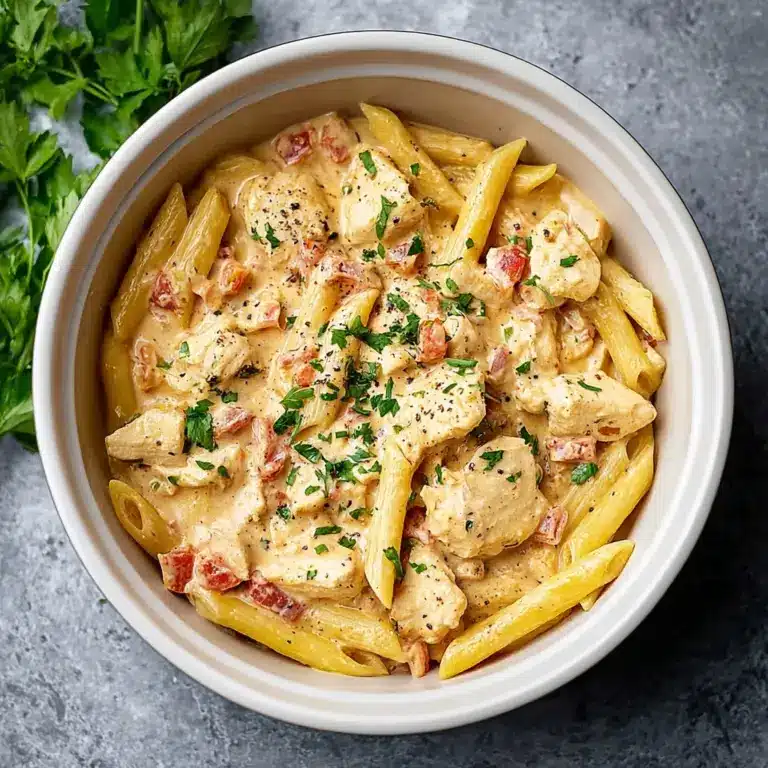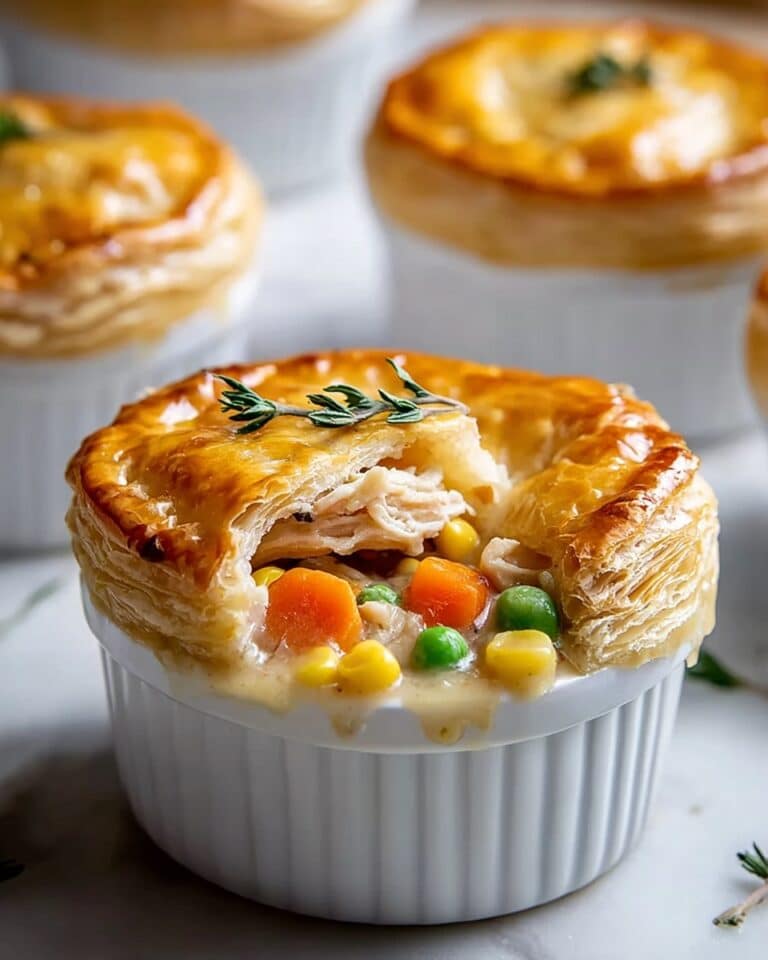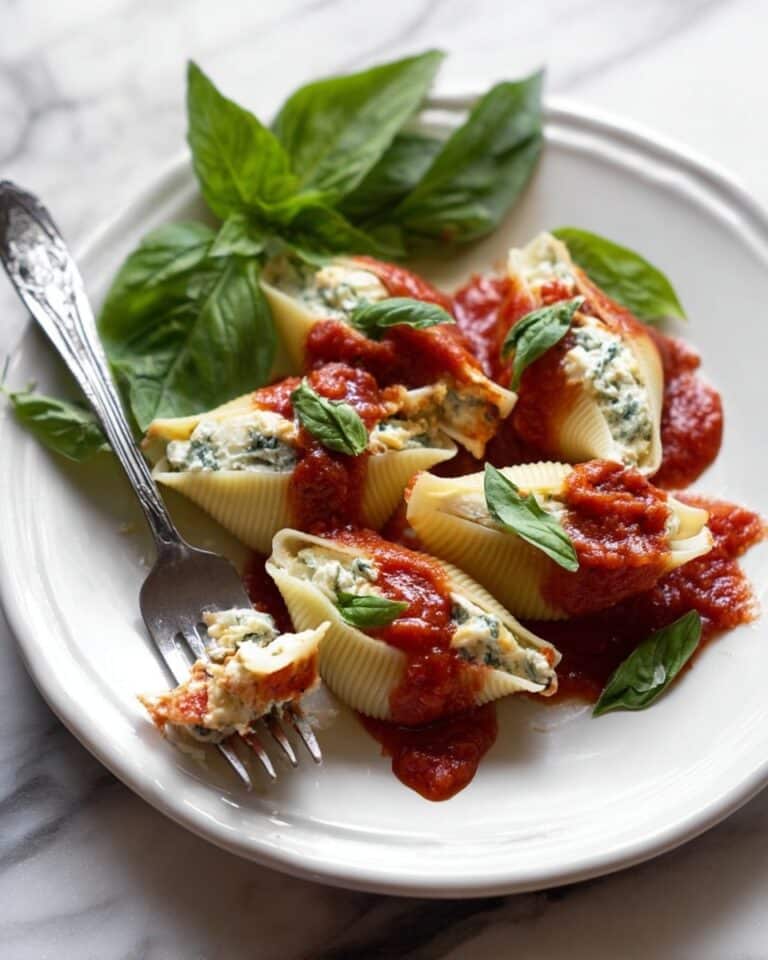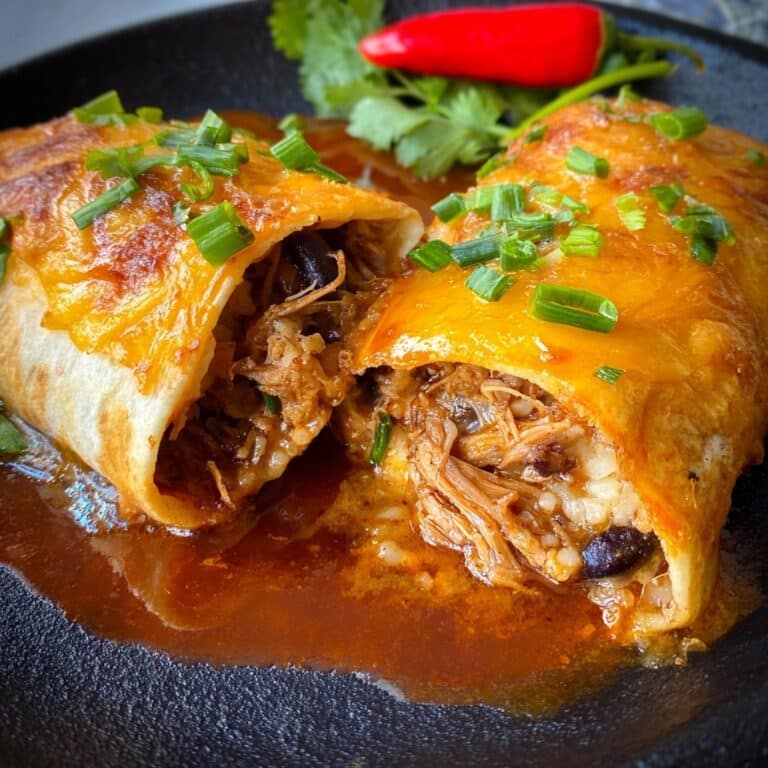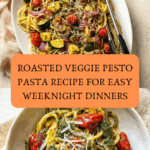Roasted Vegetable Pesto Pasta Recipe
“`html
If you’re craving a vibrant, fresh, and utterly satisfying dish, look no further than this Roasted Vegetable Pesto Pasta. It brilliantly combines the smoky sweetness of perfectly roasted veggies with the rich, nutty creaminess of homemade basil pesto, all tangled up with the comforting bite of bucatini pasta. Every forkful bursts with color, flavor, and texture, making it a fantastic meal that feels both indulgent and wholesome. Whether you’re cooking for a cozy weeknight or impressing friends at a dinner party, Roasted Vegetable Pesto Pasta will quickly become one of your go-to favorites.

Ingredients You’ll Need
These ingredients might look simple, but each one plays an essential role in building the incredible flavor and texture of this dish. From the fresh basil that gives pesto its signature brightness to the roasted veggies that add depth and sweetness, every component is worth sourcing with care.
- 2 cups basil leaves (- lightly packed): The heart of the pesto, providing fresh, aromatic herbs with a peppery kick.
- 1/2 cup parmesan cheese (- freshly shredded): Adds salty, nutty richness that elevates the pesto and pasta.
- 1/4 cup pine nuts (- toasted): Toasting deepens the flavor and gives the pesto a delightful nuttiness.
- 1 clove garlic: Just enough pungency to balance and brighten the pesto sauce.
- 1/2 cup olive oil: Brings everything together, silky smooth and full of healthy fats.
- Kosher salt and freshly ground black pepper (- to taste): Seasoning that’s crucial for pulling all the flavors into harmony.
- 1/2 medium red onion (- chopped): Adds a subtle sweetness and bite once roasted.
- 1 medium zucchini squash (- chopped): Softens when roasted, lending a tender, earthy note.
- 1 medium yellow squash (- chopped): Offers mild sweetness and vibrant color contrast.
- 2 cups cherry tomatoes: Roasting these brings out their juicy sweetness and slightly caramelized edges.
- 1-2 Tablespoons olive oil: Coats the vegetables to help them roast perfectly and develop flavor.
- 8-10 oz. bucatini pasta (- with reserved pasta water): This sturdy, hollow pasta captures sauce wonderfully and carries the veggies well.
- Parmesan cheese (- to serve): Grated over the top for that final, irresistible layer of savory goodness.
How to Make Roasted Vegetable Pesto Pasta
Step 1: Make the Pesto Sauce
Begin by combining the fresh basil leaves, freshly shredded parmesan, toasted pine nuts, garlic, and a pinch of salt and pepper in your food processor. Pulse everything a few times to break it down, then slowly drizzle in olive oil while continuing to blend until you get a smooth, vibrant green sauce. The aroma alone will have you eager to toss it with pasta!
Step 2: Roast the Vegetables
Next, spread the chopped red onion, zucchini, yellow squash, and cherry tomatoes on a baking sheet. Toss them with olive oil, salt, and pepper until everything is evenly coated. Pop the tray into a 400-degree oven and roast until the veggies are tender and just starting to caramelize. Roasting concentrates their natural sweetness and adds that smoky depth that makes the Roasted Vegetable Pesto Pasta so memorable.
Step 3: Cook the Pasta
While the vegetables roast, bring a large pot of salted water to a boil and add your bucatini pasta. Cook it until al dente so that it’s perfectly firm to the bite. Before draining, reserve about half a cup of the starchy pasta water—this liquid gold will help emulsify your sauce, making the final dish silky and cohesive.
Step 4: Combine Ingredients
In a large serving bowl, toss together the cooked pasta and roasted vegetables. Add most of your freshly made pesto along with a couple tablespoons of reserved pasta water. Stir everything gently, adding more pesto or pasta water as needed until every strand and morsel is luxuriously coated and glossy. The pesto clings to the rough surface of the bucatini, carrying all those vibrant vegetable flavors with it.
Step 5: Serve
Finally, plate up your Roasted Vegetable Pesto Pasta with a generous sprinkle of parmesan and fresh basil leaves on top. If you want to add some protein, grilled chicken, shrimp, or chickpeas work beautifully here. This dish is a celebration of color, texture, and fresh garden flavors all in one bowl, perfect for sharing or savoring solo.
How to Serve Roasted Vegetable Pesto Pasta
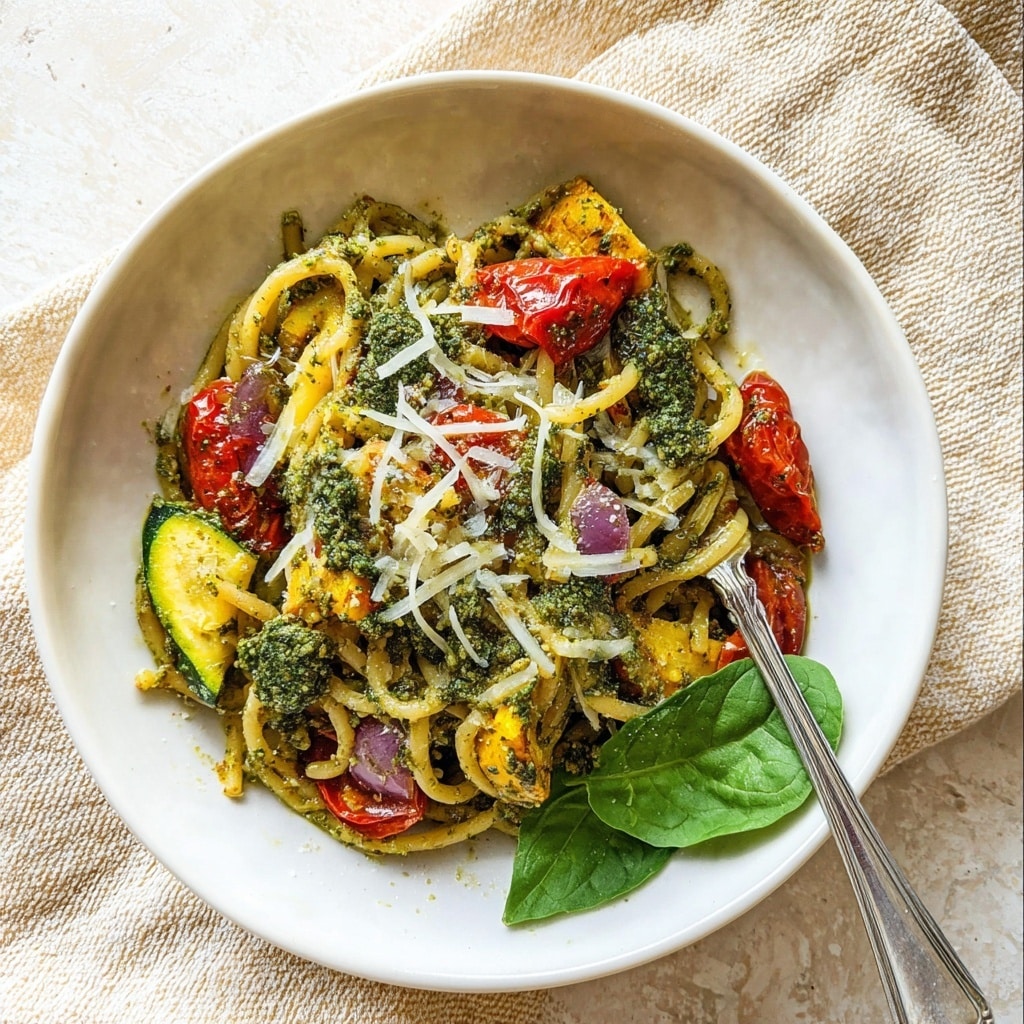
Garnishes
Fresh basil leaves add a bright herbal punch while extra parmesan lends salty creaminess that melts in your mouth with every bite. For an extra pop of texture, try toasted pine nuts sprinkled on top for crunch. A drizzle of good-quality olive oil right before serving enhances the richness and gives the pasta a beautiful sheen.
Side Dishes
Roasted Vegetable Pesto Pasta pairs wonderfully with a crisp green salad tossed in lemon vinaigrette to brighten the meal. Garlic bread or toasted baguette slices provide a satisfying crunch and help scoop up any leftover pesto. If you’re aiming for heartiness, a simple bean salad or grilled chicken skewers round out the plate perfectly without overpowering the flavors.
Creative Ways to Present
For an elegant touch, serve this pasta in individual bowls sprinkled with microgreens or edible flowers. Layer it in a glass trifle dish for a casual buffet or pack it into mason jars for an irresistible picnic treat. You can also turn it into a warm pasta bake topped with mozzarella if you prefer cheesy comfort food vibes from the Roasted Vegetable Pesto Pasta experience.
Make Ahead and Storage
Storing Leftovers
After cooking, let the pasta cool completely before transferring it to an airtight container. Stored in the refrigerator, it will stay fresh for up to 3 days. Keeping the pesto and pasta together helps the flavors marry overnight, but you may want to add a splash of olive oil or pasta water when reheating to keep it moist.
Freezing
Freezing roasted vegetable pesto pasta is possible, though pesto can darken over time. For best results, freeze the pasta and vegetables separately from the pesto sauce in airtight containers or freezer bags. This way, you can thaw and mix them fresh when ready to enjoy, preserving the bright flavors and appetizing texture.
Reheating
Reheat your Roasted Vegetable Pesto Pasta gently on the stovetop over low heat, stirring frequently and adding a little pasta water or olive oil to loosen the sauce. Avoid microwaving it at high power to prevent the pesto from tasting bitter or the pasta from drying out. A quick warm-up brings back that delicious, fresh-from-the-kitchen flavor.
FAQs
Can I use a different type of pasta?
Absolutely! While bucatini is perfect for holding onto the pesto sauce, you can swap in penne, fusilli, or even spaghetti. Just choose pasta shapes that will catch or cling to the pesto and veggies for maximum flavor in every bite.
Is this dish vegan-friendly?
The traditional recipe includes parmesan cheese, so it’s not vegan as is. However, you can easily make a vegan version by substituting the cheese with nutritional yeast or a vegan parmesan alternative to keep the cheesy umami flavor.
How long does it take to roast the vegetables?
Roasting usually takes about 20 to 25 minutes at 400 degrees, depending on your oven and how tender you like your vegetables. Keep an eye on them to avoid overcooking—soft but still holding shape is the goal.
Can I make the pesto ahead of time?
Yes! Pesto can be prepared a day or two in advance and stored in the fridge. To prevent browning, press a thin layer of olive oil over the surface before sealing. Stir well before using to refresh its vibrant flavor.
What proteins pair well with Roasted Vegetable Pesto Pasta?
Grilled chicken, shrimp, or chickpeas add great texture and protein without overshadowing the fresh vegetable flavors. For a vegetarian boost, roasted tofu or white beans make delicious, satisfying additions too.
Final Thoughts
This Roasted Vegetable Pesto Pasta is one of those dishes that feels effortlessly special yet comes together with surprisingly simple ingredients and steps. Its bright, fresh flavors combined with roasted sweetness and a nutty pesto sauce make every bite a joy. Trust me, once you try it, this pasta will be in your regular rotation, perfect for nourishing yourself and impressing anyone lucky enough to share a meal with you!
“`
PrintRoasted Vegetable Pesto Pasta Recipe
A vibrant and flavorful roasted vegetable pesto pasta made with fresh basil pesto, seasonal roasted vegetables, and al dente bucatini pasta. This dish is perfect for a quick and wholesome meal, topped with parmesan cheese and customizable with your choice of protein.
- Prep Time: 15 minutes
- Cook Time: 25 minutes
- Total Time: 40 minutes
- Yield: 4 servings 1x
- Category: Main Course
- Method: Roasting, Boiling
- Cuisine: Italian
- Diet: Vegetarian
Ingredients
Pesto Sauce
- 2 cups basil leaves (lightly packed)
- 1/2 cup freshly shredded parmesan cheese
- 1/4 cup toasted pine nuts
- 1 clove garlic
- 1/2 cup olive oil
- Kosher salt and freshly ground black pepper to taste
Roasted Vegetables
- 1/2 medium red onion, chopped
- 1 medium zucchini squash, chopped
- 1 medium yellow squash, chopped
- 2 cups cherry tomatoes
- 1–2 tablespoons olive oil
- Kosher salt and freshly ground black pepper to taste
Pasta
- 8–10 oz bucatini pasta
- Reserved pasta water (about 1/2 cup)
To Serve
- Freshly shredded parmesan cheese
- Fresh basil leaves (optional)
- Optional proteins: grilled chicken, shrimp, or chickpeas
Instructions
- Make the pesto sauce: In a food processor, combine fresh basil leaves, freshly shredded parmesan cheese, toasted pine nuts, garlic clove, and a pinch of kosher salt and freshly ground black pepper. Pulse the ingredients together, then while the processor is running, slowly drizzle in the olive oil until the sauce is well blended and smooth.
- Roast the vegetables: Preheat your oven to 400°F (205°C). On a large baking sheet, spread out the chopped red onion, zucchini, yellow squash, and cherry tomatoes. Drizzle with 1 to 2 tablespoons of olive oil, sprinkle with kosher salt and freshly ground black pepper, and toss to evenly coat. Roast in the oven until the vegetables are softened but still hold their shape, approximately 15-20 minutes. Remove and set aside.
- Cook the pasta: Bring a large pot of salted water to a boil. Add the bucatini pasta and cook until al dente, following package instructions (usually about 8-10 minutes). Before draining, reserve about 1/2 cup of the pasta cooking water, then drain the pasta.
- Combine pasta and pesto with vegetables: In a large serving bowl, add the cooked pasta and roasted vegetables. Pour about three-quarters of the prepared pesto sauce over the mixture, then add two tablespoons of the reserved pasta water to help bind everything together. Stir gently but thoroughly to distribute the sauce and vegetables evenly. Add more pesto and pasta water as needed until you reach your desired consistency and flavor.
- Serve: Plate the pasta and top with freshly shredded parmesan cheese and additional fresh basil leaves if desired. For added protein, serve with grilled chicken, shrimp, or chickpeas. Enjoy warm.
Notes
- Toast pine nuts over low heat in a dry skillet until golden to enhance their flavor.
- Do not overcook the vegetables during roasting to maintain their texture and vibrant color.
- Reserve pasta water as it contains starch that helps the pesto sauce adhere to the pasta.
- This recipe can be made vegan by substituting parmesan cheese with a vegan cheese alternative and omitting optional animal proteins.
- The pesto sauce can be prepared a day ahead and stored in an airtight container in the refrigerator.
Nutrition
- Serving Size: 1 serving (approximately 1/4 of recipe)
- Calories: 450 kcal
- Sugar: 6 g
- Sodium: 350 mg
- Fat: 22 g
- Saturated Fat: 4 g
- Unsaturated Fat: 16 g
- Trans Fat: 0 g
- Carbohydrates: 49 g
- Fiber: 6 g
- Protein: 13 g
- Cholesterol: 10 mg
Keywords: roasted vegetable pesto pasta, bucatini pasta recipe, vegetarian pesto pasta, basil pesto pasta, easy roasted vegetables


